Healthy gums are firm, pale pink, scalloped around each tooth with sharp knife edge ends in between the adjacent teeth. Although “coral pink†or “salmon pink†is the color indication for healthy gums in textbooks, racial pigmentation caused by melanin can make the gums appear darker. Mainly seen in African or Asian heritage, it can be seen in individuals of Mediterranean descent or even sometimes in light-skinned people. Due to the fact that gum color can vary between people, the uniformity of color is of more importance than the actual color itself. However if your gums are in other colors like red, white or black, they can indicate gum inflammation (gingivitis) or pathology.
Red gums
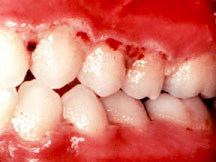
Acute necrotizing gingivitis © Too Smile Dentals
The most common color change associated with gum diseases is redness. Redness is generally seen in all inflammatory periodontal diseases. Increase in blood flow to the gums or gingival hemorrhage can be caused either by local factors (acute or chronic gingivitis/periodontitis) or by systemic disease (HIV infection and other diseases causing bleeding into the skin and mucosa of the gums).
Pale red changes indicate mild inflammation whereas bright red changes suggest a more severe or acute inflammation. A narrow band of reddening (linear marginal erythema) can be seen in HIV-related gingivitis and similar reddening can also be seen in pregnancy gingivitis.
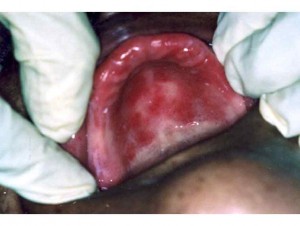
Denture-related candidiasis © IARC
Denture-related stomatitis, a mild form of chronic atrophic candidiasis consisting of inflammation of the mucosa beneath a denture, could lead to redness of the gums. A poorly fitted denture can act as a nutrient reservoir for fungal growth. Therefore dentures should be made fit and good oral hygiene should be practiced. Affected gums can be treated with antifungal agents.
White gums
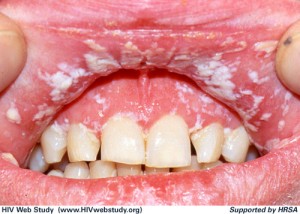
Pseudomembranous Candidiasis (Thrush) on Lips and Gums © University of Washington
If your gums become white and the white could be wiped away, then it is most probably collections of debris and dead cells or fungi (candidiasis).
- Debris are usually found in people having painful gum diseases like acute necrotizing ulcerative gingivitis, necrotizing ulcerative periodontitis or HIV-related gingivitis or periodontitis for they have a hard time keeping a good oral hygiene, leading to debris accumulation.
- Candidiasis is usually caused by the yeast Candida albicans and is more frequently seen in those with dry mouth (xerostomia), wearing dental appliances, smoking tobacco and those who have low immunity. The white plaques resembling milk curds can be scrapped away to reveal a raw, red base. Treatments for candidiasis include avoiding or reducing smoking, treat any predisposing factors like dry mouth, improving the oral hygiene with use of a chlorhexidine mouthwash and usage of antifungal agents.
Whitened gums that could not be removed by wiping can be caused by smoking, trauma, leukoplakia or manifestations of systemic diseases like lichen planus. White lesions are usually painless.
- Heavy, long-term pipe smokers and some cigar smokers can develop smoker’s keratosis whereby a diffuse white lesion would develop on the gums or more commonly, on the palate. The white lesion is due to the increase of keratin in the gum tissues which may be related to tobacco products and/or heat. Though the lesion is harmless, smoking can predispose to mouth cancer and also to cancers elsewhere in the body. Therefore smoking should be discouraged and usage of nicotine patches should be advised to break the habit.
- Trauma, such as biting on a toothless gum, may produce localized areas of gum whitening.
- White lesions that cannot be scrapped off or classified by examination are termed “leukoplakiasâ€. Leukoplakia can be totally harmless or sometimes precancerous or a marker for cancer elsewhere in the upper digestive tract. This is an uncommon condition which could most likely be seen in individuals with habits of tobacco, alcohol or betel use. Management of this condition is by removal of the risk factors and careful observation.
Other pigmentations

Amalgam tattoo
- Chronic inflammation can result in magenta changes to the gums due to the slowing of blood flow to the gums. Â Such color changes are mostly seen in individuals with established gingivitis or periodontitis.
- A single patch of blue-black pigmentation is most commonly caused by an amalgam tattoo. It is painless and usually seen close to the teeth where an amalgam filling was done.
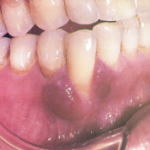
Kaposi sarcoma © SoftDental
- Kaposi sarcoma, a cancerous growth seen in HIV-infected patients, typically involves the palate or gums. Early lesions can be red, purple or brown patches on the gums.
- Drugs, such as antimalarials, minocycline, oral contraceptives, chlorhexidine mouthwash and others; can cause generalized discoloration of the oral mucosa.
- Metal poisoning such as silver, copper, lead and bismuth can cause discoloration of the gums.
Bismuth pigmentation: bluish-black discoloration of the gum margins.
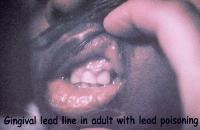
Lead poisoning © emedicine
Lead intoxication: a steel-gray pigmentation of the gum margin or blue line along the margin of the gums visible in chronic lead poisoning.
Mercury poisoning: linear dark grayish or black gum pigmentation is due to deposition of mercury sulphite.
Painful gums? Have swollen gums and lumps? Read more about the various causes for them here and here.
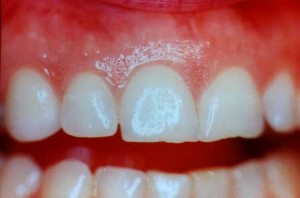
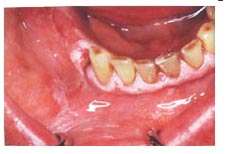
Pingback: — Tv Tattle
Pingback: Causes of Gum Swellings and Lumps Part1 | Intelligent Dental
Pingback: Avoiding Trench Mouth | Intelligent Dental
Pingback: How to Test for Syphilis | Intelligent Dental
Pingback: Chronic Adult Periodontitis: Cause and Symptoms | Intelligent Dental
Pingback: Apical Periodontitis: Symptoms and Treatment | Intelligent Dental
Pingback: Which is the Best Mouthwash for Gingivitis? | Intelligent Dental
Pingback: Wisdom Tooth Pain (Pericoronitis) | Intelligent Dental
Pingback: How Diabetes Can Affect Your Oral Health Part 2 | Intelligent Dental
Pingback: Does Teething Cause Fevers in Children? | Intelligent Dental
Pingback: How to make a Herbal Gargle to Cure Gingivitis | Intelligent Dental